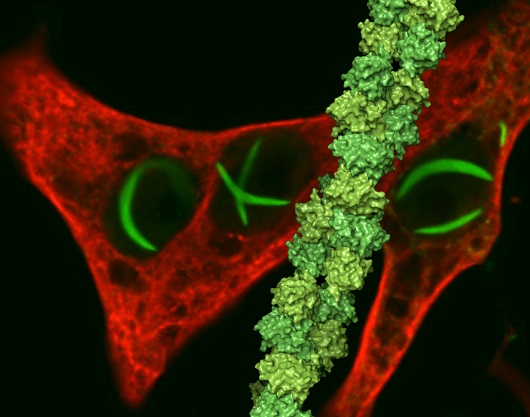Significant step made towards understanding Rift Valley Fever virus

Researchers at the Universities of St Andrews and Glasgow have made a significant step forward in tackling a viral disease which causes frequent epidemics in Africa and could spread to Europe due to global warming.
Dr Michal Barski and Dr Uli Schwarz-Linek of the School of Biology at the University of St Andrews, with colleagues at the University of Glasgow, have published a paper in online journal eLife revealing new information about a key molecule used by the virus to cause disease, which could help to eventually find a cure or a vaccine.
Rift Valley fever phlebovirus (RVFV) is a virus affecting humans and livestock which is transmitted by mosquitos and contact with infected animals. RVFV is increasingly likely to cause widespread epidemics, and could potentially follow the pattern of Dengue virus or West Nile virus and spread to temperate regions, such as Europe or the USA, as global warming allows the mosquitos which carry the virus to extend their geographic range.
Infection can cause severe disease, including haemorrhagic fever, and may lead to death. Historically, the virus was only found in central Africa but has spread to the Arabian Peninsula. There are no vaccines or treatments available for use in humans so if there is a serious outbreak of the virus it could become an epidemic and cause great economic loss and severe human disease.
The research team combined two techniques, NMR spectroscopy and X-ray crystallography, carried out at Diamond Light Source, to study the atomic three-dimensional structure of NSs – a key molecule of the RVFV virus which assembles into large fibres inside infected cells.
The virus relies on NSs to cause disease but the mechanism behind this process, and the formation of the fibres, have not been fully understood. The structure of this molecule revealed that only the central part, or core domain, of the protein is needed for the fibres to form. Further experiments identified how NSs molecules come together to build the fibres inside the infected cells.
Dr Schwarz-Linek said: “The structural insights we generated will help to unravel the complexity of Rift Valley fever. It will pave the way for research on Rift Valley fever phlebovirus and many other related viruses that have the ability to infect animals and humans.”
Dr Barski added: “With this research we have opened up a new avenue for understanding Rift Valley fever virus and hopefully also for developing therapy targeted at this virus. The recent, sudden epidemics of Ebola virus and Zika virus have highlighted the need to understand dangerous tropical viral diseases which could quickly spread to far away places. Rift Valley fever is on that very short list of viruses which might cause large epidemics next.”
These findings mark an important step towards understanding how the NSs protein helps RVFV to cause disease in humans and livestock. In the future, this work may aid the development of much needed drugs and vaccines against RVFV.
Earlier this year the World Health Organization ranked RVFV among the ten most dangerous pathogens most likely to cause wide epidemics in the near future, requiring urgent attention.
Picture caption: The NSs protein of RVFV forms characteristic filaments (green) in the nuclei of infected cells (red): a three-dimensional structure of a fibrillar assembly of NSs, determined by Barski et al using X-ray crystallography (green) is shown on top of an image of three infected cells. Image credit: Ben Brennan and Uli Schwarz-Linek.
Background information
The paper ‘Rift Valley fever phlebovirus NSs protein core domain structure suggests molecular basis for nuclear filaments’ by Barski, Brennan et al, published on 15 September 2017 by eLife. DOI: https://doi.org/10.7554/eLife.29236.002
About Diamond
Diamond Light Source is the UK’s synchrotron science facility, and is approximately the size of Wembley Stadium. It works like a giant microscope, harnessing the power of electrons to produce bright light that scientists can use to study anything from fossils to jet engines to viruses and vaccines. Diamond is one of the most advanced scientific facilities in the world, and its pioneering capabilities are helping to keep the UK at the forefront of scientific research.
Issued by the University of St Andrews Communications Office. Contact Fiona MacLeod on 01334 462108/07714 140 559 or [email protected].
Category Research